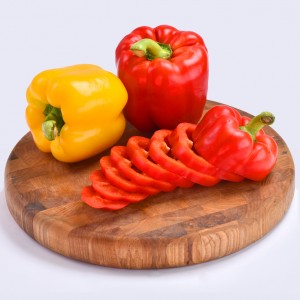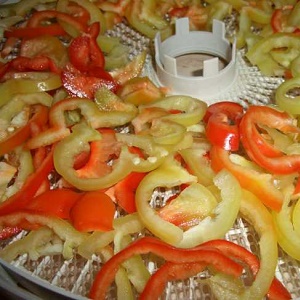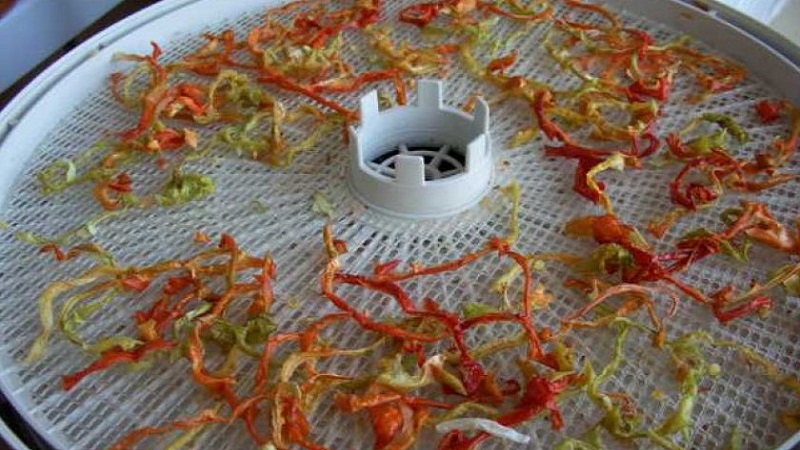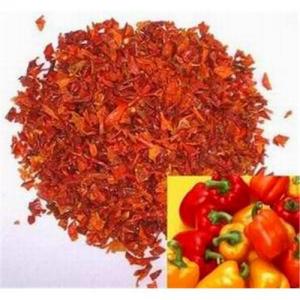How to dry Bulgarian pepper in an electric dryer: step-by-step instructions for preparing a vegetable
Bell pepper is a tasty and healthy vegetable, which contains zinc, iodine, iron, magnesium, phosphorus, sodium, potassium, calcium and vitamins A, E, B1, B2, B3, B5, B6, B9, C, PP. Therefore, it is recommended to include it in the diet all year round.
For the winter, peppers are canned, frozen and dried. The dried product retains almost all the nutrients contained in fresh fruits. At home, peppers are dried in several ways: in the oven, in an electric dryer and in the open air. Consider how to dry Bulgarian pepper in an electric dryer.
The content of the article
The benefits of dried bell peppers
 Due to the high content of vitamins (especially vitamin C), micro- and macroelements in pepper, it recommend to eat with low immunity, vitamin deficiency and impaired metabolism... Vitamins A and E contained in the dried product strengthen nails and hair, improve skin condition and speed up its regeneration.
Due to the high content of vitamins (especially vitamin C), micro- and macroelements in pepper, it recommend to eat with low immunity, vitamin deficiency and impaired metabolism... Vitamins A and E contained in the dried product strengthen nails and hair, improve skin condition and speed up its regeneration.
Dried pepper spices have a beneficial effect on work gastrointestinal tract, improving and speeding up digestion. Therefore, paprika is beneficial for weight loss. It helps with indigestion, stomach cramps, gas in the intestines, flatulence.
Sweet peppers are shown to be consumed by people with diseases. musculoskeletal system (arthritis, radiculitis) and cardiovascular system. It strengthens blood vessels, is important in the prevention of blood clots, helps with bleeding gums, anemia.
It is not recommended to eat dried paprika when angina pectoris, high blood pressure, increased acidity of the stomach, ulcers of the gastrointestinal tract, liver and kidney diseases, allergies to the product.
Vegetable preparation
Fruits for drying are selected ripe, juicy, without signs of spoilage.... Rinse thoroughly in running water, allow to dry. Then the stalk and seed chambers are removed, cut into rings 4-5 mm thick with a knife or vegetable cutter. Or the fruit is cut in half, the stalk and seeds are removed, cut into half rings or strips (4-5 mm thick).
Waste is 20-30%. So, from 10 kg of prepared pepper, you will get 7-8 kg of a refined product.
Take a note:
How to freeze peppers for the winter for stuffing
Drying technology and methods
At home bell peppers are dried in several ways:
- on open air;
- in the oven;
- in an electric dryer.
Drying in an electric dryer - faster and more reliable way.
Cooking method in an electric dryer
 Place the cut slices on pallets, preferably in one layer.... Filling in two or more layers will increase the drying time.
Place the cut slices on pallets, preferably in one layer.... Filling in two or more layers will increase the drying time.
The pallets with the product are placed in the dryer. Set the Medium mode, set the temperature to 50-55 ° C. Cooking time depends on the size of the pieces and is about 10-12 hours.
During drying for more even drying, the trays can be interchanged.
Method of drying sweet peppers in an electric dryer with salt
You can dry the pepper immediately with salt... For 2 kg of bell pepper you need 2 tsp. salt. The fruits are washed in running water. Cut in half, remove stalks and seeds. Then the peppers are chopped into half rings 4-5 mm wide, laid out on trays and salted. This amount of product will require five pallets. The dryer is set to Medium mode (with a temperature of 50 ° C).Drying time is 10-12 hours. The finished product is stored in paper bags.
Readiness check
To check readiness, squeeze the slice with your fingers.: the finished product crunches. Liquid should not stand out from it.
Finished pepper is reduced in size by 10-12 times. So, from 1 kg of chopped fresh vegetables, you will get 80-100 g of dry product.

Storage of the finished product
It is better to store the finished product in a linen or paper bag, which is easily breathable.... If a plastic bag is used for storage, it is not necessary to close it tightly. A glass jar is also suitable for storage, but you will need a lid with holes.
The storage container is placed in a cool dry place., hidden from direct sunlight.
Read also:
The use of dried peppers in cooking
Dry pepper used for cooking various dishes... It goes well with meat, fish, poultry and vegetables. Dried slices are added to soups, sauces, vegetable stews, gravies.
For the preparation of some dishes, pepper is restored... It is filled with water for 15-25 minutes, after which it becomes soft. This pepper can be used to bake bread by adding it to the dough along with herbs and sesame seeds. This will give the baked goods a spicy taste and aroma.
Dried peppers are ground in a blender and get a powder - dried paprika... It is used as a separate component or mixed with other vegetables and herbs.
 The resulting spice-vegetable mixtures are added to soups, stews, marinades and dressings:
The resulting spice-vegetable mixtures are added to soups, stews, marinades and dressings:
- Pepper and tomato seasoning... 1 tbsp. dried bell pepper, 1 tbsp. dried tomatoes, garlic and herbs (parsley, dill, green onions) to taste, grind and mix. Store in a glass jar in a dark place. Add to soup, vegetable stew, stew.
- Vegetable seasoning... 1 tbsp. dried bell pepper, 1 tbsp. dried tomatoes, 0.5 tbsp. dried carrots, 2 tbsp. l. dried onions, garlic and herbs (parsley, dill, green onions) to taste, grind in a coffee grinder or food processor and mix. Store in a dark place in a glass or porcelain jar. Add to taste in soups and vegetable stews.
The proportions and ingredients in such seasonings can be changed to your liking.
Paprika is used in Asian and European dishes as an independent seasoning... It gives not only aroma and taste, but also a reddish tint. To avoid the taste of the dish, do not subject the paprika to prolonged heat treatment.
Ground sweet pepper blends harmoniously with bay leaf, garlic, basil and hot pepper. But don't mix it with cilantro and onions.
Conclusion
Bell peppers are rich in vitamins, micro and macro elements. Is it possible to preserve these substances in it as much as possible when harvesting the fruit for the winter? Yes, you can - by properly drying it.
Drying in an electric dryer is the easiest and most reliable way to preserve pepper, which does not require much time and effort, but thanks to which tasty and healthy products will be on your table in winter.